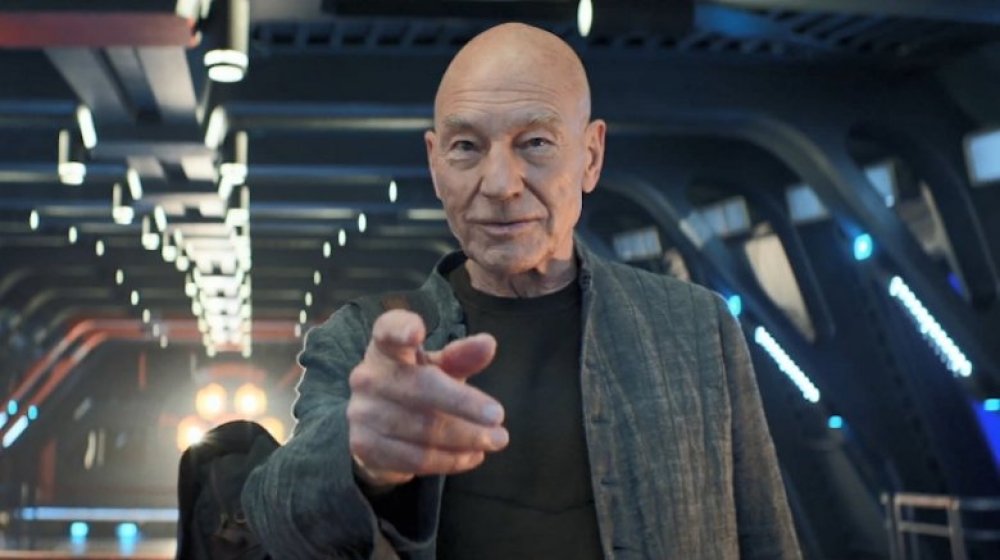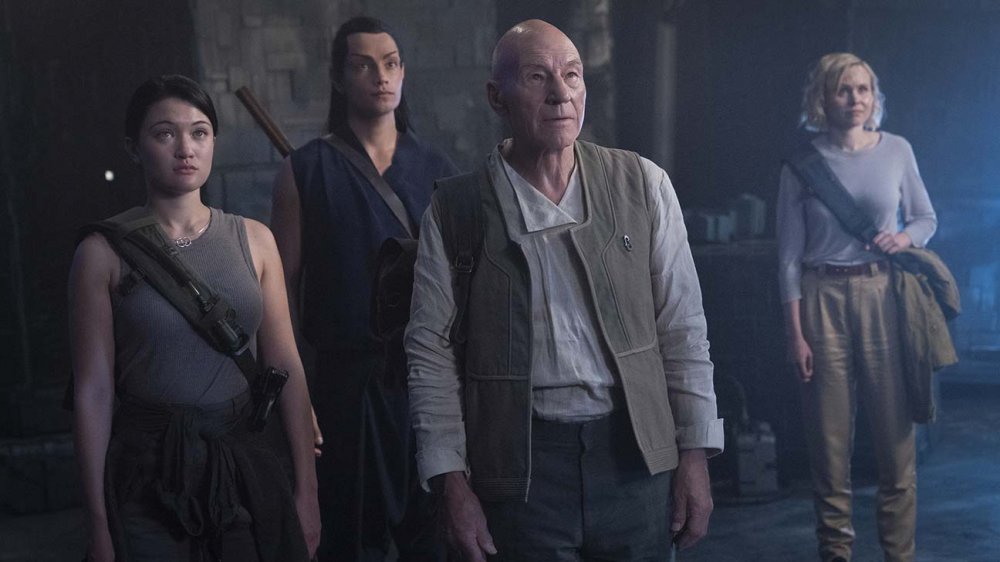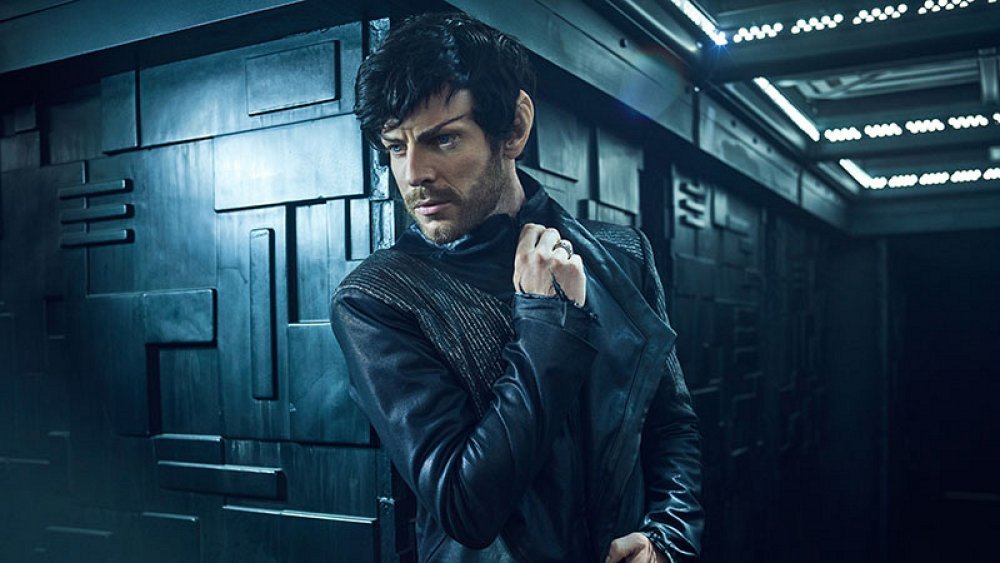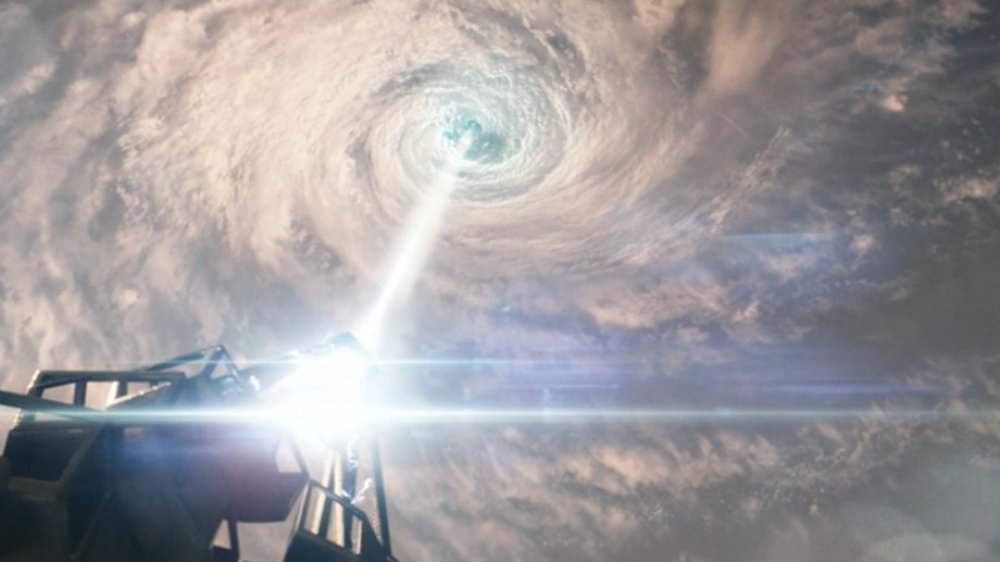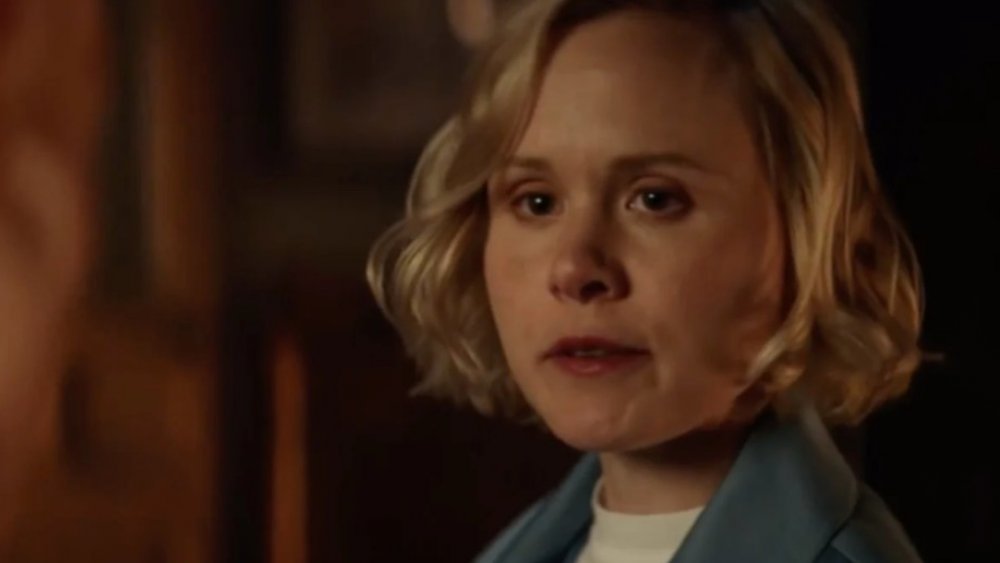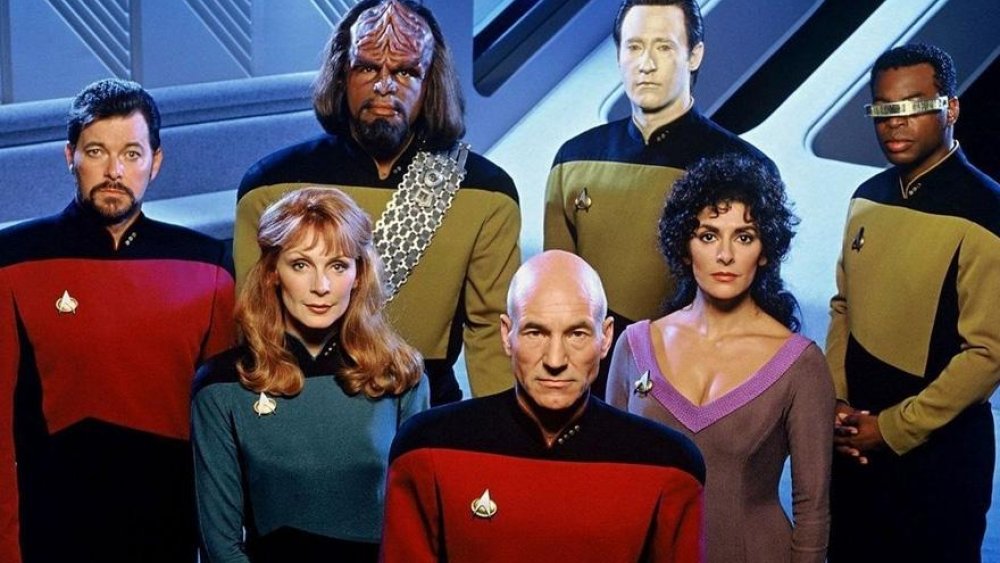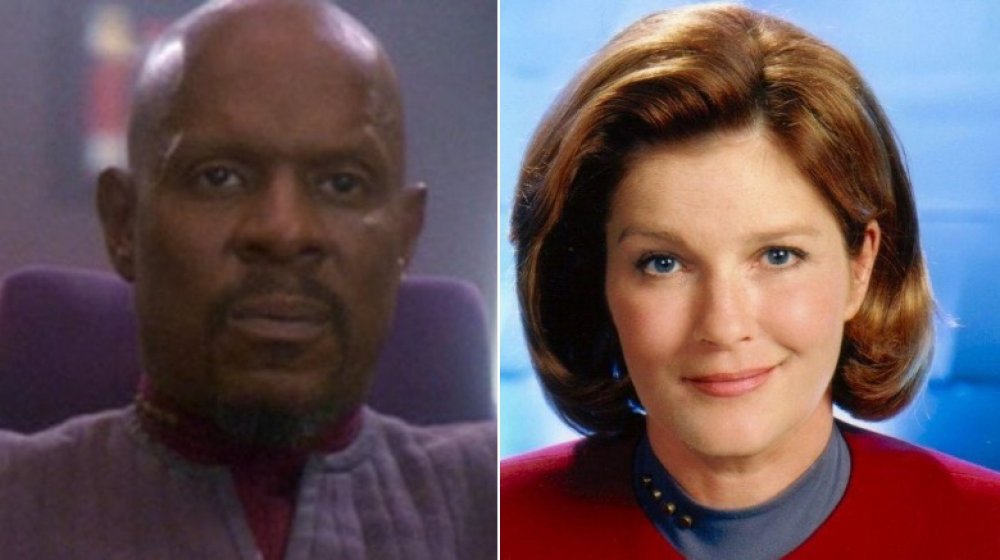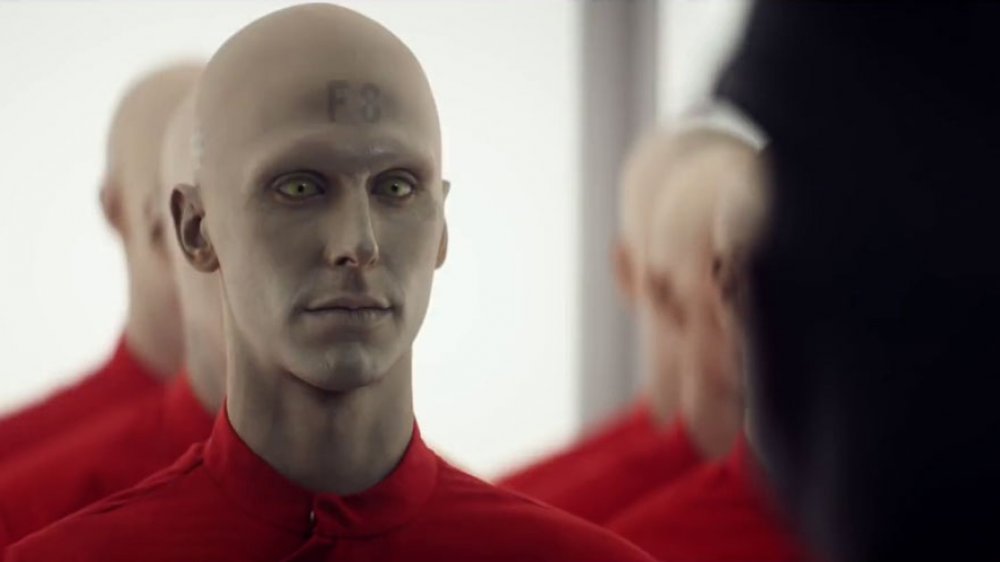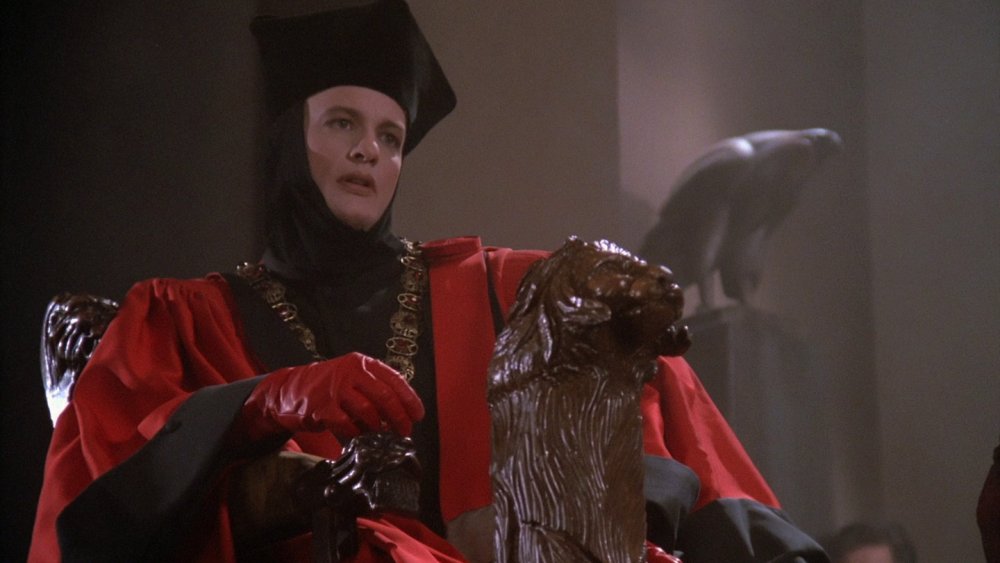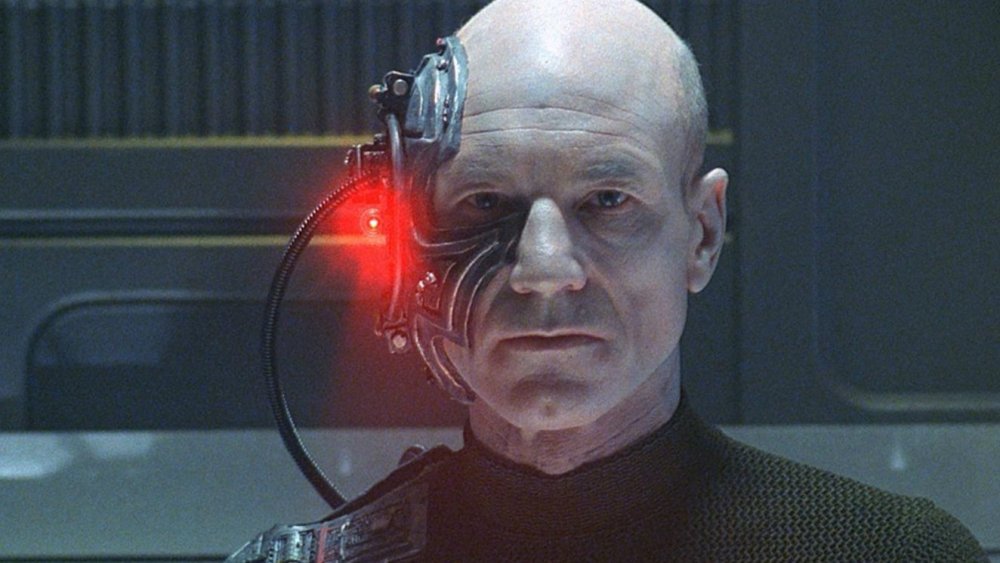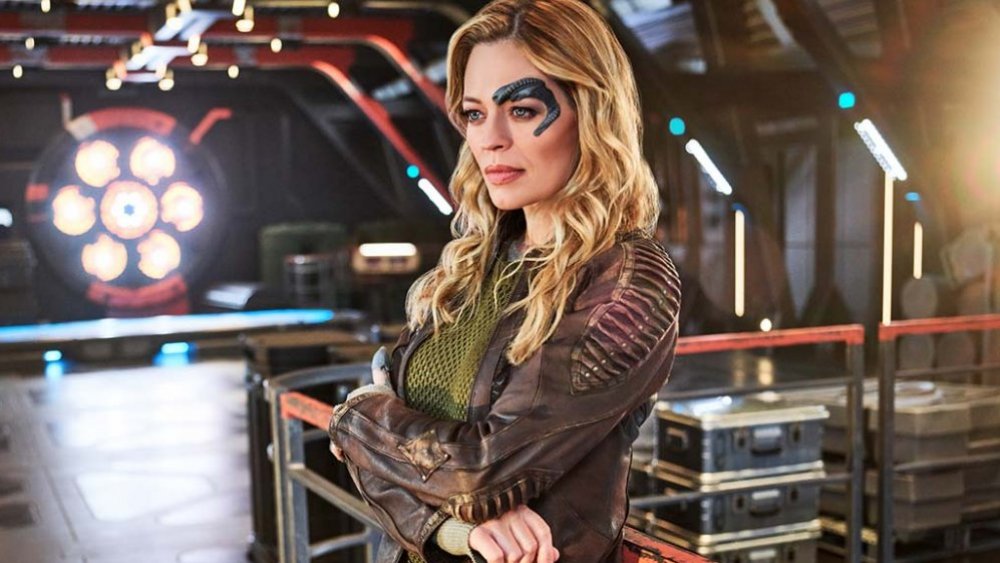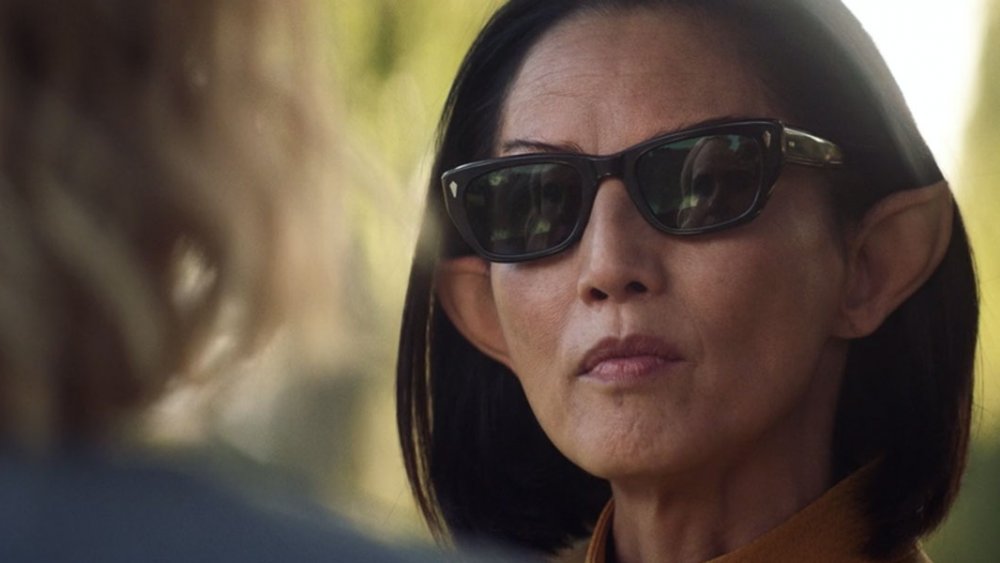Biggest Unanswered Questions From Season 1 Of Star Trek: Picard
WARNING! SPOILERS FOR SEASON 1 OF STAR TREK: PICARD FOLLOW!
If you've been following the new adventures of the former Captain of the Enterprise, then you know CBS All Access' first season of Star Trek: Picard has come to an explosive close. At the last minute, Soji (Isa Briones) shuts down the beacon to the powerful synthetic lifeforms prophesied to destroy all organic life. Will Riker (Jonathan Frakes) leads a fleet of ships in a standoff with the Zhat Vash, and the Romulans blink first. Seven of Nine (Jeri Ryan) goes one-on-one with the Zhat Vash agent Narissa (Peyton List) and Jean-Luc Picard (Patrick Stewart) finally succumbs to Irumodic Syndrome. Thankfully, Picard's consciousness is transferred to a new synthetic body; before he wakes up, Picard gets to say goodbye to his old friend Data (Brent Spiner).
Picard opens with a host of mysteries and a lot of those have been unraveled, but there's still a lot that's been left unsaid. For example, the fates of some characters were conspicuously missing, and in other cases characters have changed in surprising ways that still haven't been fully explained. The events of the season finale have potentially far-reaching ramifications that we can't predict, and there are still plenty of old friends and enemies we're waiting to hear from.
We think these loose ends — and more — make up the biggest unanswered questions from season 1 of Star Trek: Picard.
Will the new crew stay together
At the end of Picard's season 1 finale the heroes are on board La Sirena, presumably on their way back home. A new romance appears to be blooming between Seven of Nine and Raffi (Michelle Hurd), while Captain Rios (Santiago Cabrera) and Dr. Jurati (Alison Pill) seem to be continuing their relationship. Picard and Soji are there, as well as the Romulan warrior Elnor (Evan Evagora).
But will this crew stay together? After all, this isn't like Star Trek: The Next Generation (TNG). None of them are active Starfleet officers. La Sirena has no extended mission to explore anything. Jurati came aboard as a spy for the Zhat Vash, Elnor's there to help Picard in the mission that's already concluded, and Rios has more than completed the job Picard's paying him for.
We're guessing something will pop up in season 2 of Picard to keep its titular hero in the stars — and in the meantime, the writers have provided the glue for these characters to stay together. Even though officially Elnor only agreed to the mission to save Soji, he idolizes Picard and will probably go wherever the retired admiral does. Jurati has romantic reasons to stay on board La Sirena, as does Seven. As for Soji, why not follow her new friends on other adventures now that she remembers her life on Earth was a sham?
What happened to Narek?
One character who is conspicuously missing from the end of Picard's season 1 finale is Narek (Harry Treadaway). The Romulan spy spent most of the season seducing Soji so he could manipulate her into triggering her memories and revealing the location of her homeworld. Eventually we learn that while Narek and other members of the Zhat Vash are merciless, their goal isn't without merit. They mean to stop a galactic apocalypse they call Ganmadan which they believe will be caused by the higher order of synthetics — the so-called Synthetic Alliance — Soji and her brethren mean to summon. The last we see of Narek, he and some of the heroes have tried and failed to destroy the synthetics' beacon. We don't see him aboard La Sirena when it leaves, and the Zhat Vash fleet leaves Coppelius without beaming him up.
Picard showrunner Michael Chabon addressed this through his Instagram (via ComicBook.com). Apparently there wasn't enough time to show the resolution to Narek's story, which presumably would include learning Seven of Nine killed his sister. In an Instagram story, Chabon said, "Yeah. Narek. We know, we know. A casualty of the editorial process, alas. The intention was for him to be taken into Federation custody."
That doesn't necessarily mean that will prove to be what happened, however. Since we never saw it happen, the writers could always choose a different fate for the sneaky Romulan.
Who is the Synthetic Alliance?
"Et in Arcadia Ego: Part 2" — the season 1 finale of Picard — has its heroes facing two opposing threats. On one hand there's the massive Romulan fleet ready to decimate everyone and everything on the planet Coppelius. On the other, there's the Synthetic Alliance that Soji means to summon to protect her and other synths. Unfortunately, the Alliance's supposed method of protecting other synthetic life is to eradicate all organic life — Romulan, human, and everything in between.
We don't see much of the Alliance, but we're shown enough to be convinced of the danger. After the portal opens, we see huge mechanical tendrils — like massive tentacles — reaching out. Picard convinces Soji to shut down the beacon and close the portal, keeping whatever was on the other end of those tendrils in their own corner of the universe.
We're left without knowing much about the Synthetic Alliance. How did it come into being? Where are they from? How many of them are there? Do they truly mean to wipe out all organic life, or have we misunderstood their intentions? After all, while what we see come out of the portal looks menacing, at the time the Romulan fleet was planning to wipe out all the synths on Coppelius.
Perhaps the most pressing question of all: now that they know about the synths on Coppelius, will we be seeing them again?
Will Dr. Jurati face justice for killing Bruce Maddox?
"Stardust City Rag" has possibly the most shocking ending of any episode in Picard's first season. After being reunited with her colleague and lover Bruce Maddox (John Ales), Dr. Jurati murders him in La Sirena's sick bay. In "Nepenthe," we learn that the Zhat Vash spy Commodore Oh (Tamlyn Tomita) approached her on Earth before Jurati joined La Sirena's crew and used a mind meld to give her a vision of the galactic apocalypse the Zhat Vash fear.
Once the other heroes learn of Jurati's betrayal, initially they seem eager to get her off the ship. Picard has every intention of turning her in to the Federation. Later, they seem more understanding, believing she was not in control of her actions when she murdered Maddox. Shortly after the airing of the season finale, Michael Chabon answered fan questions for TrekMovie.com, and while the season ends without Jurati being arrested, Chabon said "She will put herself in the hands of the law."
So we know Jurati intends to take responsibility for what she did, though it remains to be seen what consequences — beyond her own guilt — she'll have to face. Considering the influence of Commodore Oh and Jurati's help in the showdown above Coppelius, there's good reason to think they'll go easy on her. Then again, the Federation has changed; it might be tough to predict what they'll do.
Where is the rest of the TNG crew?
Picard isn't the only old friend we're reunited with in the first season. Along with Seven, some other TNG alums show up. Data stops by and we get to see Riker make pizza, while Deanna Troi (Marina Sirtis) proves as insightful as ever. We even get to a chance to see Jonathan Del Arco reprise the recurring TNG role of Hugh, a Borg drone who becomes an individual.
But what about everyone else? Wesley Crusher was nowhere to be found in the story even though Wil Wheaton hosted Picard's aftershow, The Ready Room. We don't hear from Beverly Crusher (Gates McFadden), Worf (Michael Dorn), or Geordi LaForge (Levar Burton). Nor do we know what any of them have been doing in the intervening years. Worf is made Federation ambassador to the Klingon Empire in the series finale for Star Trek: Deep Space Nine (DS9), but we don't know whether he still holds the position as of the events of Picard or if he's moved on.
We know for sure at least one TNG cast member will show up in season 2. The day before Picard's series premiere aired on CBS All Access, Patrick Stewart appeared on The View to invite co-host Whoopi Goldberg to reprise her recurring TNG role of Guinan for Picard's second season. Goldberg happily agreed — hugging Stewart and appearing emotional for the rest of the segment.
What about other characters from Voyager and DS9?
Fans were pleasantly surprised to see Seven of Nine — who never even met Jean-Luc in any of the series or films — as a recurring character in Picard. There are still plenty of fans who love DS9 and Star Trek: Voyager who would love to see heroes from those shows return at least briefly in future episodes of Picard.
We haven't seen Voyager's former captain Kathryn Janeway (Kate Mulgrew) since her cameo in 2002's Star Trek: Nemesis, when we learn she's been promoted to admiral since her return to the Alpha Quadrant. There are plenty of questions we'd love to have answered about the rest of the Voyager crew. Is The Doctor (Robert Picardo) still around? Would Chakotay (Robert Beltran), Torres (Roxann Dawson), and other former Maquis crew have to answer for their crimes after returning to Earth?
Then there's the DS9 alums. Besides Worf, we haven't seen any of the regular cast of DS9 reappear in a Trek production since the series finale, though "Stardust City Rag" shows us through an Easter egg that Quark (Armin Shimerman) has moved his operations to Freecloud. Is Ben Sisko (Avery Brooks) still with The Prophets? Asked which two DS9 characters he would bring aboard La Sirena if he could, Michael Chabon named the enigmatic exiled spy Garak (Andrew Robinson) and the Cardassian's best friend, Doctor Bashir (Alexander Siddig). We expect fans would be happy to see either of those old friends again.
How will synths fare in the Federation?
At the end of the season finale, we learn that with the revelation that the synthetic attack on Mars was orchestrated by the Zhat Vash, the Federation lifts its ban on synthetic life. That's good news for Picard, since technically he has become a synthetic lifeform.
But while allowing synthetics to exist in the Federation may be the right thing to do, it doesn't seem likely everyone is going to be comfortable with it. The attack on Mars is portrayed as a deeply traumatic event for the Federation. We learn the fires caused by the assault still rage on the red planet years later. It's difficult to imagine that with so much loss of life touching so many people, there won't be a vocal group of Federation citizens against the ban's lifting. It seems likely it will be a long time before the Federation sees synths in regular use as they were at the Utopia Planitia Shipyards.
Picard might find himself the target of anti-synthetic prejudice. What will happen when those closest to Picard find out, biologically speaking, he's no longer human? Especially considering Picard is the same man who unwittingly helped the Borg almost bring the Federation to its knees?
Is Q watching?
Of the major figures in Picard's life, the one most conspicuously absent so far from Picard is the trickster entity Q (John de Lancie). First encountering Picard in TNG's premiere episode "Encounter at Farpoint" and hounding the Enterprise captain throughout the series — including in the series finale — Q develops a particular interest in Picard over the course of TNG. While Q would often claim to be testing humanity, it's eventually clear that for better or worse, Picard is important to the powerful alien.
It's difficult to take in the events of Picard without imagining Q watching from somewhere in the Q Continuum with fascination and amusement. Picard is synthetic now? Can you imagine all the jokes Q would get from that development? Not to mention we never got to see Q in any of the movies. What would he have to say about the return of the Borg in 1996's Star Trek: First Contact or the conflict with Picard's clone in Nemesis?
Of course, it could be that Q no longer exists. That's not likely considering he's basically immortal, but it isn't out of the realm of possibility. In TNG we see him temporarily stripped of his powers, and in Voyager the Continuum suffers a destructive civil war. A Picard/Q reunion would be amazing, but who knows if it's in the cards?
Is Picard's connection to the Borg severed?
After Picard's assimilation by the Borg and subsequent rescue in TNG's two-parter "The Best of Both Worlds," Dr. Crusher removes his Borg implants. Regardless, it's clear he still retains some connection to the Collective. For example in First Contact, he dreams of the Borg shortly before learning of their new assault on the Federation and he guesses they're on their way before Starfleet tells him. During the battle with the Borg cube, he knows exactly what part of the enemy ship to strike.
But Picard's first season ends with the hero's consciousness transferred into a synthetic body. Which means, ironically, becoming fully synthetic may have finally freed him from his connection with the Borg. We don't know exactly what it was that kept his link to the Collective alive, but it seems reasonable that whatever it was would not carry over to his new body.
Of course, anything's possible in Star Trek and we could eventually learn there's still a part of Locutus — no matter how small — within Picard. But maybe his goal to get back the rest of his humanity somehow needed him, physically speaking, to lose it.
How did Seven develop such strong emotions?
The Seven of Nine we meet in Picard is very much a changed woman since her days aboard Voyager, and not just because she wears her hair down and has jettisoned the skintight outfits. In Voyager Seven keeps her feelings in check as much as a Vulcan, while in Picard Seven expresses powerful emotions. Speaking to Syfy Wire, Jeri Ryan said the moment Seven finds Icheb (Casey King) and mercy kills him in "Stardust City Rag" is probably "the first time that Seven truly let go of her emotions."
But that leads us to a big question: How are Seven's powerful emotions even possible? In "Human Error" — an episode in Voyager's final season — Seven uses holographic simulations to help with her social skills and to continue exploring her humanity. Eventually we learn that experimenting with emotion is more dangerous than she realizes. The Doctor reveals her Borg implants include a failsafe that will shut down her higher brain functions if her emotions are stimulated too much. He offers a potential surgical solution, but Seven turns him down.
From what we've seen in Picard's version of Seven, that failsafe definitely should have gone off if it's still active. Maybe after so many years of separation from the Borg, the failsafe stopped working. Or maybe she finally allowed the Doctor or someone else to perform the necessary surgery. Regardless, Picard doesn't give us the answer.
Is this the end of the Zhat Vash?
Picard's first season ends with the Zhat Vash's plan to annihilate the synthetics foiled, but their overall goal of stopping the galactic apocalypse they believe the Synthetic Alliance will cause is fulfilled without their help. Picard convinces Soji to destroy the beacon and close the portal to the higher order of synths; faced with the prospect of a battle with a Starfleet armada, the Romulans leave Coppelius unscathed.
What happens to the Zhat Vash now? They've operated for centuries within the Tal Shiar but now their existence has been brought to light. It isn't clear whether they're officially sanctioned by the Romulan government. If not, then they've made a target of themselves. Not only did they almost bring the Romulan Empire to war with the Federation, but they failed in their mission. The Romulan Empire is not the kind of place where failure is rewarded, or even tolerated.
You could argue that with their Ganmadan averted, there's no longer any reason for the Zhat Vash to exist, though we're willing to bet they could find a reason to keep going. Of the members we've met, at least one — Narissa, the woman who kills Hugh and is later killed herself by Seven — finds any kind of artificial life disgusting. Sadly, that kind of hatred usually defies logic and finds a way to thrive.
